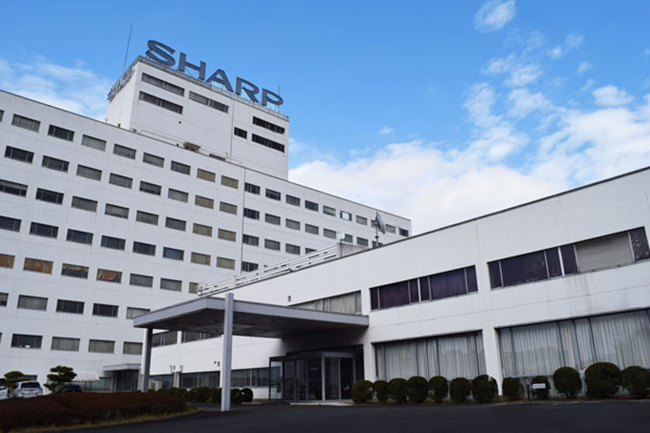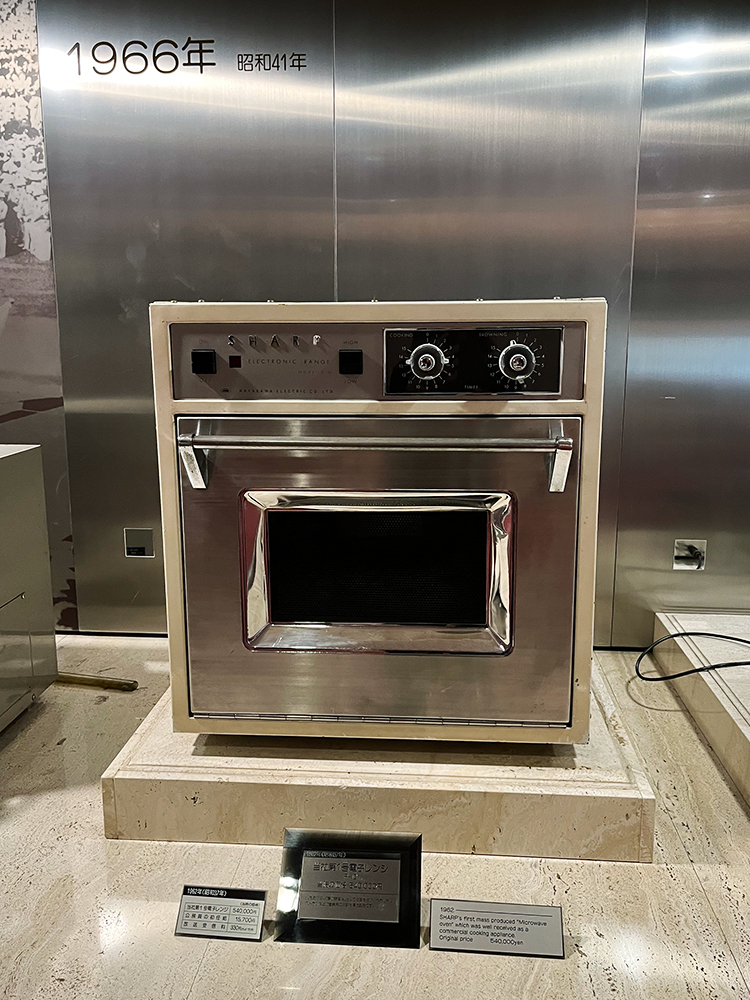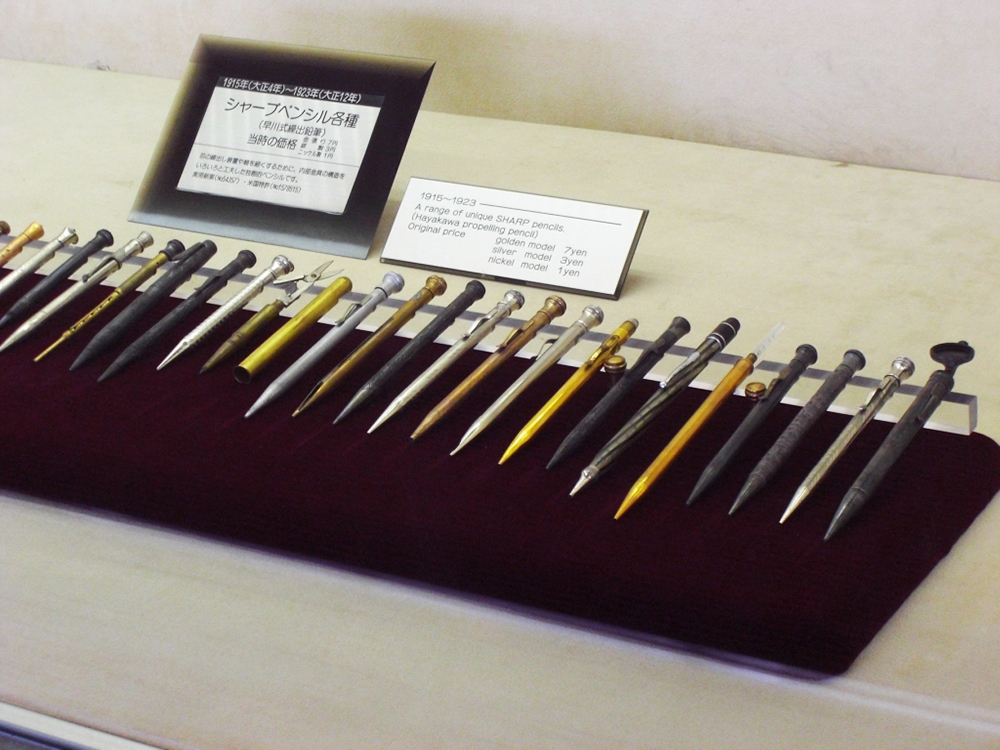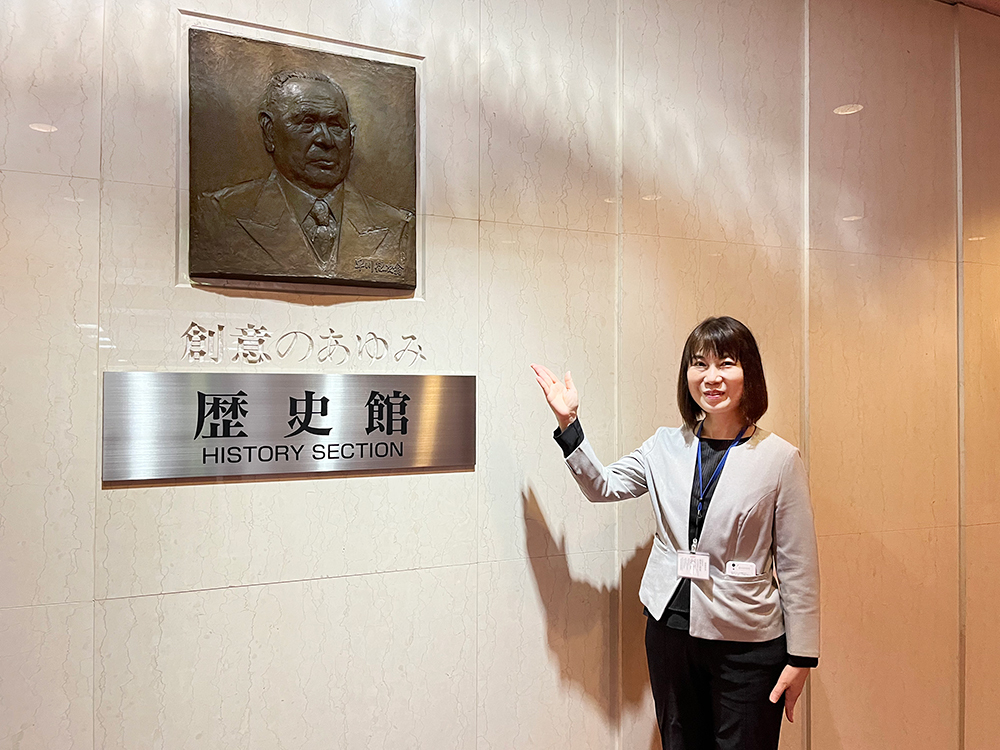Note: This website was automatically translated, so some terms or nuances may not be completely accurate.
The Drama and the Essence of Guides at the Sharp Museum

Corporate museums must have "drama." A professor from the Smithsonian Institution in the United States once said this during a visit to the Sharp Museum. Simply displaying products and presenting the company's history on panels makes it difficult to convey the appeal. Drama isn't just about success stories. It's the presence of numerous hardships that draws people in. This time, we want to examine the existence and role of the guides who continue to convey this "drama" at the Sharp Museum.
Reporting and Text: Reina Okuuchi (PR Consulting Dentsu Inc.)

A 15-minute bus or taxi ride from Tenri Station in Nara Prefecture. The Sharp Museum is located within the vast "Sharp Integrated Development Center," spanning approximately 230,000 square meters. Visitors often react with comments like "It's surprisingly low-key" or "I had no idea a museum was here," making it a corporate museum known only to those in the know. However, once inside, positive feedback pours in: "I learned a lot," "It was interesting," "I want to bring my family next time." What exactly makes this museum so appealing?
Overview of the Sharp Museum
The museum's origins date back to 1980. To mourn the passing of founder Tokuji Hayakawa (1893–1980, honorifics omitted in text) and preserve his legacy for future generations, the "Sharp History Hall" opened to the public in October 1981. The following November, the "Technology Hall" opened to showcase cutting-edge technological achievements to select stakeholders. Both halls were later opened to the public, and in 2012, the facility was renamed the "Sharp Museum," a name it retains today.
The museum consists of two floors: the History Hall and the Technology Hall. The History Hall, with a total floor area of 813 square meters, displays approximately 290 historical Sharp products. The Technology Hall, covering 527 square meters, showcases around 100 exhibits illustrating cultivated technologies, such as the solar cell production process and the development of liquid crystal displays. To date, the museum has welcomed over 640,000 visitors from Japan and abroad. Groups of five or more can receive guided tours, while smaller groups and individual visitors can borrow self-guided terminals utilizing the company's latest technology free of charge.

A Small, Elite Operational Team
The museum operates with just two staff members. This small, elite team handles everything from reservation management and group tours to facility maintenance. This necessitates close collaboration with other departments. For example, media-related tasks like interviews and photography are handled by the PR section. External exhibitions and social media communications involve coordination with PR, Design, and Brand sections. For exhibition renewals or events, broad collaboration is required with the responsible headquarters and related companies.
Another distinctive feature is the strong support provided by a group of enthusiastic former Sharp employees who volunteer for museum operations. These volunteers actively use Instagram to share highlights of the museum and trivia about exhibits. During peak seasons for field trips and school excursions, they also serve as guides, assisting with student group management. Supported by these dedicated volunteers, the museum maintains smooth operations despite its small staff.
Sharp's Manufacturing: Filled with Vision and Originality
The museum chronologically displays numerous products that were first in Japan or the world, such as the nation's first radio and television, and the world's first LCD calculator. These exhibits reveal Sharp's history of foresight, leaving visitors amazed. A prime example embodying this foresight is the "Sorocal." SoloCal, as its name suggests, integrated an abacus and a calculator. Though hard to imagine today, when calculators first appeared, some people distrusted whether calculations were truly accurate. To allow for verification, it was sold with an abacus attached.

Moreover, many features now taken for granted actually originated with Sharp. For instance, the term "to microwave" (チンする) comes from Sharp being the first to incorporate microwave cooking into its ovens. When first introduced, chefs at restaurants using the microwave complained that food cooled down too quickly after opening the door because it heated up so fast. This led to the idea of a bicycle bell. Inspired by a developer's personal experience at a company cycling event where ringing a bell alerted the rider ahead to move out of the way, Sharp incorporated a mechanism directly linking the timer to a bell that would sound.

Other exhibits at the museum include products that were too innovative to gain widespread market acceptance, such as the "Hige-Dora" (Beard-Dora), a combined shaver and dryer, and the "Rate-Ka-Pyuta" (Radio-TV-Cassette-Computer), which integrated a radio, TV, cassette recorder, and computer. These showcase Sharp's foresight and originality.
Furthermore, Sharp has achieved the remarkable feat of being the first company in Japan to receive the prestigious IEEE Milestone Award in three distinct fields: calculators, solar cells, and liquid crystal displays, all recognized for their significant contributions to regional and industrial development.

This visionary and innovative approach to manufacturing at Sharp originates from the message Tokuji Hayakawa often emphasized: "Create products that others will imitate." This philosophy continues to be passed down as a core management principle and belief. What kind of person was founder Tokuji Hayakawa?
Tokuji Hayakawa's DNA: Sincerity and Ingenuity
Born in Tokyo in 1893, Tokuji Hayakawa began his apprenticeship at the young age of eight. There, he learned metalworking techniques that would later shape his manufacturing, along with a passion for selling and the knack for capturing customers' hearts. After striking out on his own, he developed and patented the mechanical pencil (Hayakawa-style retractable pencil) in 1915, which became the origin of the company name. Though repeatedly rejected by stationery stores he visited to sell his product, he persevered through trial and error, creating one new product per week. The high quality and design became the talk of the town, leading to exports overseas and a huge hit. Subsequently, it began to gain popularity domestically, putting his business on a solid footing. Looking closely at the top of the displayed mechanical pencils, you can see various ingenious features, such as those with scissors, thermometers, or compasses attached.

Despite the rapid growth of the mechanical pencil business, the Great Kanto Earthquake destroyed factories and other assets, forcing the transfer of the mechanical pencil business to a company in Osaka. He resolved to start a new business in Osaka himself. The new venture he discovered was radio. Ahead of the broadcasts starting the following year, he disassembled imported crystal radios for study. Using the metalworking skills he had cultivated, he manufactured parts and succeeded in assembling Japan's first domestically produced crystal radio set in 1925. The company then grew as a radio manufacturer.
When the radio business began to thrive, he foresaw the coming era of television and challenged himself to research it. By 1951, he succeeded in creating a prototype television, and in 1953, he began mass production of Japan's first domestically produced television. He also worked to reduce prices, greatly contributing to its adoption in households. I am deeply impressed by the fact that Hayakawa Tokuji's manufacturing spirit, brimming with sincerity and creativity, continuously opened up new markets.
The Importance of "Conveying the Drama" Beyond Success Stories That Bring Visitors Closer
We asked Yuriko Fujiwara, a member of the Open Innovation Center within the Research and Development Headquarters who guided us through the museum, what she focuses on when serving as a guide. She emphasized "conveying the drama." She shared an event that made her realize its importance. Around 2006, when a professor from the Smithsonian Institution, one of America's leading museums, visited the Sharp Museum, Ms. Fujiwara posed this question: "What is missing from this museum?"
The professor reportedly replied, "It lacks 'drama.'" Indeed, the museum displays completed historical products. However, upon receiving this critique—that it lacked exhibits showcasing the human encounters and anecdotes behind development—Ms. Fujiwara had a sudden realization. Since then, she has made a conscious effort to incorporate development stories into her guided explanations, drawing from historical materials and interviews with retired employees. "Drama isn't just about success stories, so it captures listeners' interest, and frankly, it allows us guides to be more honest," says Fujiwara. He says he feels daily how conveying these dramas significantly bridges the gap with visitors. As I toured the museum myself, I was captivated by the numerous anecdotes shared by Fujiwara, feeling as if I were witnessing the vibrant, passionate development scene firsthand.

The Significance of the Museum's Existence
What significance does the Sharp Museum hold as a PR asset? Ms. Fujiwara explained: "Our 110-year journey has involved countless hardships, decisions, and human connections. Each time we overcame adversity, we gained something, lost something, and left something behind—all of which led to where we are today. We see this museum's mission as passing that legacy on to the next generation."
A company's 110-year experience holds diverse hints for solving the social challenges of the next era. The Sharp Museum is the place where these insights can be shared with many people. Another employee who joined the interview added, "This museum itself can be seen as the management philosophy. While the shift to a new management structure in 2016 might have raised concerns about the company changing, the founder's spirit remains an unalterable legacy passed down to every employee. It serves as a place not only for new hires but also for experienced hires to revisit and reaffirm the company's origins." Many employees who visit express sentiments like "I've grown to like our company even more" or "I feel pride in our company," making it a key hub for internal communication.
Future Developments and Challenges
Driven by a desire to share Sharp's legacy and cultivated technologies with a broader audience, the company is currently working on archiving its content. As part of this effort, Sharp's official Instagram features nostalgic past products centered around exhibits, while Sharp's official note platform runs a series introducing small dramas from the museum's daily life. Further content expansion is planned. If there is a challenge, it lies in training the next generation of guides. While content is important, the presence of these storytellers is equally vital. Interactive communication, which is difficult to convey through audio guides, is what creates visitor engagement. "Wouldn't it be great if we had our own avatars?" Mr. Fujiwara smiled during the interview.
Captivating visitors with the many stories spun by guides
The Sharp Museum is brimming with surprises and discoveries that make you want to share them with someone. Visitors can find hints for solving problems or spark new ideas. They'll also likely feel anticipation for what new innovations Sharp will bring next. Furthermore, the presence of guides who convey these stories is an indispensable part of the museum's charm. Right from the start of the tour, I was completely drawn into the guide's narrative, feeling as if I were traveling through Sharp's story itself. This must stem from the guide's passion and the high level of communication skills cultivated through trial and error. I highly recommend visiting the museum to experience the essence of their guiding firsthand.
[Editor's Note] (From the Web Dentsu Inc. Editorial Department)
Home appliances hold dreams. Refrigerators, washing machines, vacuum cleaners, microwave ovens... each is indispensable infrastructure supporting our lives. Yet, the company SHARP gives the impression of not merely enhancing the performance of this infrastructure, but of confronting dreams and bringing them to life.
Dreams are something very lyrical and elusive. They seem like something scientists and engineers shouldn't even speak of. Yet SHARP confronts dreams. To deliver SHARP's unique dreams into the daily, seemingly unchanging routines of life.
Was this article helpful?
Newsletter registration is here
We select and publish important news every day
For inquiries about this article
Back Numbers
Author

Reina Okuuchi
PR Consulting Dentsu Inc.
Senior Consultant
At the Planning & Consulting Bureau, I was involved in planning for domestic manufacturers and education-related clients. Since 2017, as the PR Manager at PR Consulting Dentsu Inc., I have promoted initiatives to invigorate internal communications, including external PR, launching an internal web newsletter, and planning and operating anniversary virtual events. My hobby is watching quiz shows. Certified PR Planner by the Japan Public Relations Association.




